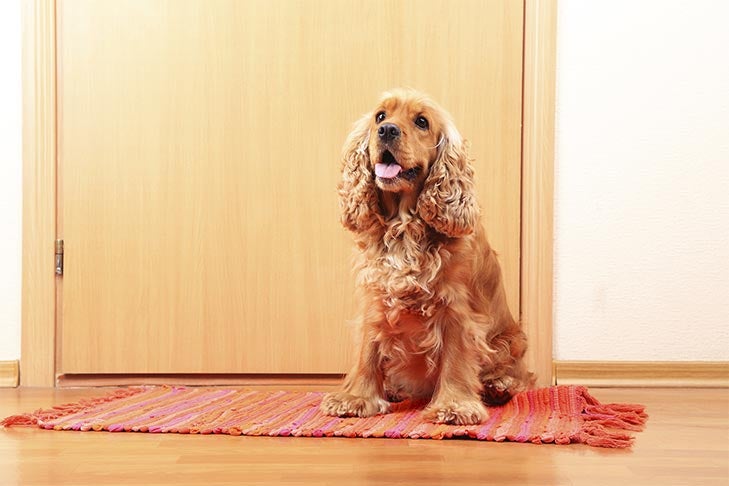
Do you worry about your dog escaping every time you open your front door? Do they burst out of the car in busy parking lots before you can get them leashed? Doors are a safety hazard for dogs who haven’t been taught doorway manners. Rather than struggling at doorways, teach your dog to wait for permission to pass through. Sometimes you will give that permission, and other times you won’t. But either way, your dog should understand the decision is up to you.
The Benefits of Training Wait
Doorway safety is essential with car doors and those that exit your home. A dog who rushes through as soon as the door opens is at risk – they could run away or be hit by a car. Of course, you can manage the situation to prevent escape. For example, a baby gate across the front hall will block your dog’s access to the front door. But wouldn’t it be easier to teach your dog to stay inside until you say otherwise?
Teaching your dog to wait at doorways is also convenient. You can bring bags of groceries into the house without your dog knocking you over while they try to make their getaway. Doorways inside your house could benefit from good manners too. It’s hard to carry a load of laundry through a door with a dog bumping against your legs. And don’t forget about the crate door. Does your dog push it open as soon as you unlatch it? It’s far more polite if they wait until you say they can leave. Finally, wait is a great way to teach your dog emotional self-control.
How Wait Is Different From Stay
You might be wondering how the wait cue is different from stay. Couldn’t you just ask your dog to stay when you open the door? You could, but technically, if you ask your dog to stay when you go out for an hour-long jog, they should still be in the exact same position when you return. Not many dogs could handle that kind of request. Stay means “stay in that exact position until I release you.” Whereas wait means “hold on a moment.”
Unlike stay, it doesn’t matter what your dog is doing while they wait. They can sit, stand, or even walk away. Plus, you don’t always release your dog from a wait. The release word means your dog can pass through the doorway. However, that won’t always be the case. There are plenty of times you will tell your dog to wait but not release them through the door. Therefore, it’s helpful to train these two distinct behaviors with two different cues.

How to Train Wait
Although you can eventually have your dog waiting at any kind of door, this is safest to train with an inside door so if your dog gets past you, they aren’t at any risk of escaping. It’s also easiest to train with the door opening toward you. Ensure your dog’s success by making sure there’s nothing exciting happening on the other side of the door. The following steps will teach your dog to wait:
- When your dog is settled, open the door a crack. As soon as your dog approaches the door, close it again.
- Continue to slightly open then close the door until your dog realizes they can’t go through. They might stand still, look away, back away, or even sit to show they understand. When they do, use a clicker or marker word like “Yes” to mark the moment, then praise your dog and offer a treat.
- Now slowly increase the amount you open the door. Again, close it if your dog moves toward it. If they stay still, click/mark/praise and reward.
- Once you can open the door completely without your dog moving through, you’re ready to add a verbal cue like “wait” or “hold on.” You can also add a hand signal such as swinging your open palm in front of your dog’s nose. Simply give the cues before you open the door.
- Now you’re ready to add your own movement. After you’ve opened the door, take a single step into the doorway, then return to your dog and click/mark/praise and reward them for staying on their side.
- Increase your steps, one at a time, until you can go completely through the doorway into the other room. Again, return to your dog to click/mark/praise and reward.
- Now add a release word like “Okay” or “Free” on some of your training trials and allow your dog to pass through the doorway. That’s a life reward, so make it special. Play a game with your dog when they pass through or toss a favorite toy or ball. This will teach your dog that waiting can lead to wonderful things and is therefore worth their while. On the other trials, continue to leave the room then return to your dog before rewarding them. You can even close the door before you open it again and return.
- Take your training to other doors like the crate or car. But be aware that each new location is a new challenge and some doors, like those that lead to the yard, have incredible distractions on the other side. So, take a few steps back in the process every time you try a new door. And for doors leading outside, leash your dog as an extra safety precaution.
Troubleshooting Wait at Doorways
When you begin training, if your dog is having trouble settling down, ask them to sit before you open the door. But you don’t want your dog to become reliant on that cue. In the end, an open door should be enough to make them hold back. So, drop the sit cue as soon as you can. And if your dog is confused about the release word, encourage them through the door by acting excited or calling their name.
Your dog will make some mistakes. But you don’t want them to realize they don’t have to listen. Therefore, anytime your dog ignores your cue and goes through a door, lead them back to the original side of the doorway and repeat your cue, this time being quicker to catch any slipups.

